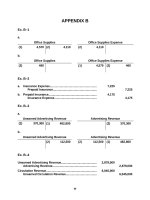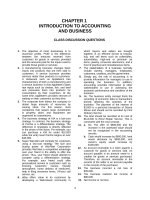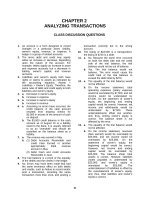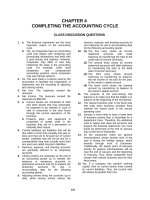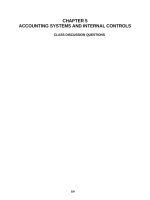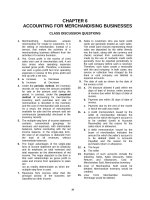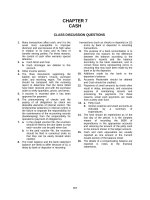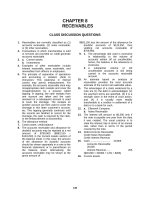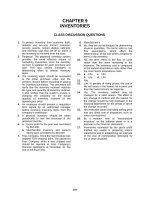Solution manual investments 10th by jones ch05
Bạn đang xem bản rút gọn của tài liệu. Xem và tải ngay bản đầy đủ của tài liệu tại đây (58.38 KB, 15 trang )
Chapter 5:
How Securities Are Traded
CHAPTER OVERVIEW
Chapter 5 allows students to concentrate solely on the
mechanics of securities trading after learning about financial
markets in Chapter 4. This material typically is of great
interest to most students, and instructors must decide how much
time and effort to devote to it.
Chapter 5 devotes considerable attention to the major
aspects of brokerage transactions. An important part of this
discussion centers around brokers themselves, a subject which
tends to interest many students quite a lot. The chapter
discussion explains what brokers do, the types of brokerage
operations (full-service vs. discount vs. deep discount), how
brokers are compensated, and how much they make annually.
The remainder of the brokerage transaction discussion covers
the major points that students need to know. These include the
types of brokerage accounts, commissions, investing without a
broker, how orders work, the types of orders, clearing
procedures, using the internet, and so forth. Instructors will
wish to vary their discussions of this material depending upon
student knowledge, interest, time availability, and current
discussions in the popular press.
There are numerous interesting illustrations that can be
given of brokerage costs, how orders work on the exchanges and in
the OTC, market orders versus limit orders, and so forth. The
popular press regularly has articles that would be appropriate
for class discussion, including Smart Money, Worth, Forbes,
Business Week, and Financial World.
Chapter 5 contains a thorough discussion of investor
protection in the markets, a topic of concern to many investors.
This covers not only federal legislation and the SEC but also
self-regulation by the stock exchanges, including the latest
measures on the NYSE such as trading halts and sidecars. The
role of the NASD in regulating brokers and dealers also is
covered. An extended example of regulation involving penny
stocks is given.
48
The remainder of the chapter is devoted to margin trading
and short selling. These are important subjects, and ones that
many students have difficulty understanding, particularly short
selling. It is suggested that instructors spend a reasonable
amount of time explaining these concepts.
CHAPTER OBJECTIVES
To provide students with a good understanding of what
brokers do, how securities are traded, and so forth as a
natural extension of the discussion of financial markets in
Chapter 4.
To explain the mechanics of securities trading, such as
brokerage transactions, margin trading, and short selling.
To provide an overview of how markets are regulated without
simply describing the various federal acts.
49
MAJOR CHAPTER HEADINGS [Contents]
Brokerage Transactions
Brokerage Firms
[full-service brokers, discount brokers, how brokers earn
their income, examples of discount brokers]
Types of Brokerage Accounts
[cash vs. margin, asset management account, wrap account]
Commissions
[negotiated rates; examples]
Investing Without a Broker
[dividend reinvestment plans; direct stock purchase
programs]
How Orders Work
Orders on the Organized Exchanges
[how orders work on the NYSE; specialists; automation on the
NYSE]
Orders In The Over-The-Counter Market
[bid price and asked price]
Decimalization of Stock Prices
[NYSE and Nasdaq convert to decimals]
Types of Orders
[market, limit, stop]
Clearing Procedures
[settlement date; street name; clearing houses]
Investor Protection In The Securities Markets
Government Regulation
[Federal legislation; the SEC; insider trading]
50
Self-Regulation
[regulation by the NYSE--trading halts, sidecars, Rule 80A;
the role of the NASD]
Other Investor Protections
[Securities Investor Protection Corporation (SIPC);
arbitration]
One Example of Regulation--The Case of Penny Stocks
Margin
[definition; types; margin calls; examples]
Short Sales
[definition; examples; details of short selling]
Appendix 5-A
The Details of Margin Accounts
POINTS TO NOTE ABOUT CHAPTER 5
Tables and Figures
Table 5-1 outlines the details on types of orders: market,
limit and stop orders. The intent is to present this material in
a concise format, and illustrate it with examples.
Table 5-2 contains a brief description of the major
legislative acts regulating the securities markets. This
material can be very tedious when presented as regular text.
This presentation better allows instructors to devote as much, or
as little, time as they desire.
Table 5-3 presents the details of short selling. Such
details are important, and this presentation helps to keep these
details from being “lost”.
51
Box Inserts
There are no boxed inserts for this chapter.
52
ANSWERS TO END-OF-CHAPTER QUESTIONS
5-1.
A market order ensures that a customer’s order will be
executed quickly, at the best price the broker can
obtain. Thus, an investor who wants to be certain of
quickly establishing a position in a stock (or getting
out of a stock) will probably want to use a market order.
A limit order specifies a particular price to be met or
bettered. The purchase or sale will occur only if the
broker obtains that price, or betters it. Therefore, an
investor can attempt to pay no more than a certain price
in a purchase, or receive no less than a certain price in
a sale; a completed transaction, however, cannot be
guaranteed.
A stop order specifies a certain price at which a market
order takes effect. The exact price specified in the
stop order is not guaranteed, and may not be realized.
Limit orders are placed on opposite sides of the current
market price of a stock from stop orders. For example,
while a buy limit order would be placed below a stock’s
current market price, a buy stop order would be placed
above its current market price.
5-2.
Most securities are sold on a regular way basis, meaning
the settlement date is three business days after the
trade date. The three-day settlement period--T+3--took
effect in mid-1995.
5-3.
By keeping their securities in a street name, investors
transfer the safekeeping function to their brokers;
furthermore, upon sale they do not have to worry about
delivering the securities to the broker.
Possible disadvantages include the financial failure of
the brokerage house, resulting in at least a temporary
tie-up of the securities. Also, an investor may wish to
use securities for collateral, and it can take weeks to
have them delivered from a street name.
5-4.
Margin is the equity that a customer has in a
transaction. The Board of Governors of the Federal
Reserve System sets the initial margin, which is the
percentage of the value of a securities transaction that
the purchaser must pay at the time of the transaction.
The purchaser then borrows the remainder from the broker,
traditionally paying as interest charges the broker loan
rate plus 1-2% (approximately). Completion, however, may
result in significantly different rates paid by the
customer.
In addition to the initial margin, all exchanges and
brokers require a maintenance margin below which the
actual margin cannot go (this is typically 30% or more).
5-5.
Actual margin between the initial and maintenance margins
results in a restricted account where no additional
margin purchases are allowed.
If the actual margin declines below the maintenance
margin, a margin call results, requiring the investor to
put up additional cash or securities (or be sold out by
the brokerage firm).
5-6.
If an investor sells short, he or she is (usually)
selling a security that is not owned. The broker borrows
the security from another customer (who owns it), and
lends it to the short seller who must subsequently
replace it. In effect, the investor from whom the
security is borrowed never knows it since his or her
monthly statement continues to reflect a long position.
5-7.
Short sales on the exchanges are permitted at the last
trade price only if that price exceeded the last
different price before it. Otherwise, the seller must
wait for an uptick. This restriction does not apply to
OTC stocks.
5-8.
A sell limit order and a buy stop order are above the
current market price.
A buy limit order and a sell stop order are below the
current market price.
5-9.
The margin requirement for U. S. government securities is
10 percent or less.
5.10.
With a wrap account, investors with large sums to invest
use a broker as a consultant to choose an outside money
manager from a list provided by the broker. All costs
are wrapped in one fee--the cost of the brokerconsultant, the money manager, and transactions costs.
For stocks, a typical fee is 3% of the assets managed
(and less for larger accounts).
5-11.
A discount broker offers reduced brokerage commissions
relative to full-service brokers such as Merrill Lynch
but also offers most of the same services, the exception
being research reports and recommendations/advice. Large
discount brokers include Fidelity, Charles Schwab, and
Quick and Reilly. Investors can visit an office, call a
broker at one of these firms, or use their internet
facilities.
Deep-discount brokers offer bare-bones brokerage
commissions but little else. These firms tend to be
quite small and provide services primarily over the
internet.
5.12.
More than 800 companies offer dividend reinvestment
plans, whereby dividends can be used to purchase
additional shares of the company paying the dividend.
Many companies now offer direct purchase stock plans,
allowing investors to purchase shares directly from the
company. Exxon is a good example. Investors can open a
direct-purchase account with Exxon to buy its stock.
5-13.
The role of
such as the
and orderly
often going
specialists is critical on an auction market
NYSE. They are expected to maintain a fair
market in those stocks assigned to them,
against the market.
As brokers, specialists maintain the limit book, which
records all limit orders. The commission brokers leave
the limit orders with the specialist to be filled when
possible, paying a specialist a fee to do this.
As dealers, specialists buy and sell shares of their
assigned stocks to maintain an orderly market. The
specialist will buy from commission brokers with orders
to sell and sell to those with orders to buy, hoping to
profit by a favorable spread between the two sides.
5-14.
SuperDot is an electronic order routing system for NYSElisted securities. Member firms send orders directly to
the specialist post where the securities are traded and
confirmation of trading is returned directly to the
member firm over the same system. The system has order
processing capacity of 800 million shares a day.
SuperDot also includes components to handle both
preopening buy and sell orders and postopening market
orders.
5-15.
Both of these terms apply to limit orders. An open order
remains in effect for six months unless canceled or
renewed. A day order is effective for only one day.
5-16.
The mission of the SEC is to administer laws in the
securities field and to protect investors and the public
in securities transactions. In general, it administers
all securities laws.
5-17.
The National Association of Securities Dealers (NASD)
regulates brokers and dealers. All brokers must register
with the NASD in order to trade securities. The NASD can
bar individuals from association with any NASD member;
having done so, it has no jurisdiction over the
individual. The NASD can fine an individual. Penalties
can be appealed to the SEC, which suspends the monetary
penalties until resolution.
5-18.
Investors are interested in margin accounts because such
accounts permit the magnification of gains (but also
losses). With a margin requirement of 50%, percentage
gains are doubled (ignoring transaction costs and
interest costs) because the investor only has 50% of the
value of the transaction at stake; that is, his or her
own equity is only 50% of the value of the transaction.
The risks are obvious. If the transaction goes against
the investor, the percentage losses are doubled, and
interest costs must still be paid.
Investors are required to have margin accounts for some
transactions, such as short sales.
5-19.
Short sales account for approximately 9 percent of all
reported sales. The public accounts for about one third
of short sales on the NYSE, with NYSE members accounting
for about two-thirds.
5.20.
The basis of regulation of mutual funds is the
Investment Company Act of 1940. This federal act has
been incredibly successful in regulating the investment
company industry, providing almost total confidence in
investors as to the operations of investment companies.
5-21.
The Investors Advisors Act of 1940 simply requires wouldbe investment advisors to fill out a form and pay a fee
to register with the SEC. There are no education or
competency requirements. Therefore, investors have no
assurances as to the abilities of people offering advice.
5-22.
The NYSE has established certain trigger points referred
to as “circuit-breakers” that are designed to reduce
market volatility. Rule 80B was revised in 1998.
Trigger levels are now set at 10%, 20%, and 30% of the
DJIA, calculated at the beginning of each quarter.
Trading halts of one hour and two hours are associated
with the 10% and 20% declines (but vary depending upon
time of day). A decline of 30% closes the market for the
rest of the day.
5-23.
Investors may choose to use a full-service broker for
several reasons. First, they may have confidence in a
particular broker and wish to have the personal contact
implied in such a relationship. Second, they can seek,
and obtain, advice from the broker, and by extension, the
entire resources of a firm such as Merrill Lynch. Third,
they can obtain considerable research reports and
investing information, which are often extensive in
nature. Fourth, full-service brokers may offer a wider
range of services than many discount brokers, and
investors needing such services will want to have them
available.
5-24.
The SEC does not provide assurances to investors when an
IPO is marketed in terms of being able to tell investors
that the company will be successful. The SEC does ensure
that the company selling the new securities has complied
with various accounting and legal provisions, thereby
hopefully preventing the sale of new securities based
upon fraudulent or misleading information.
5.25.
The specialist system on the exchanges assigns stocks to
specialist firms, who then make a market in the stock.
Specialists buy from and sell to the public to maintain
an orderly market in the stock. The system has worked
well over the years, and has provided some notable
successes in maintaining orderly markets. For example,
in the great crash of October 19, 1987, specialists
remained at their posts, trading stocks and providing
liquidity.
Dealers in the over-the-counter market make markets in
stocks, buying from investors and selling to them from
their inventory. Thus, they have a vested interest in
each transaction, and in the spread between the bid and
asked price. Investigations in the 1990s revealed that
these spreads often were too wide relative to what should
be expected. In many cases, these spreads have narrowed
since these investigations.
ANSWERS TO END-OF-CHAPTER PROBLEMS
5-1.
5-2.
(a)
A limit order to sell is placed above the
current market price. If the limit order is
set at $130, the investor will realize a gross
profit of at least $30 (ignoring transaction
costs).
(b)
A sell stop order is placed below the market
price. If the stop order is placed at $120, the
investor should realize a profit of
approximately $20 per share. Technically, to
be certain of $20 per share, the stop order
probably would have to be set slightly above
$120 because a stop price is actually an
activator that initiates a market order when
the specified price is reached.
To realize a gross profit of $5000 on 200 shares
sold short at $75, the investor must cover at
(ignoring transaction costs):
200($75) = $15,000
X
───────
= $ 5000 profit
X is $10,000, which must be divided by 200 shares.
ANSWER:
$50 per share
For a profit of $1000, the calculation is:
$15,000
X
───────
$ 1000
X is $14,000, which again must be divided by 200
shares.
ANSWER:
5-3.
$70 per share.
100 shares at $50 per share is a total cost of
$5000. At 50% margin, the investor must put up
$2500, resulting in a gross profit percentage
relative to equity of
$1000/$2500 = 40%
At 40% margin, the investor must put up $2000,
resulting in a gross profit percentage relative to
equity of
$1000/$2000 = 50%
At 60% margin, the investor must put up $3000,
resulting in a gross profit percentage relative to
equity of
$1000/$3000 = 33.3%
5-4.
The initial margin is 50% of $6000, or $3000.
other $3000 is borrowed from the broker.
The
(a)
market value of securities - amount borrowed
actual margin = ────────────────────────────────────────────
market value of securities
$5000 - $3000
= ─────────────
$5000
= 40%
(b)
In a restricted account, the actual margin is
between the initial margin (i.e., 50%) and the
maintenance margin (i.e., 30%). The actual margin
is now:
market value of securities - amount borrowed
actual margin = ────────────────────────────────────────────
market value of securities
$5500 - $3000
= ─────────────
$5500
= 45.5%
Therefore, the account is restricted.
(c)
A margin call results when the actual margin
declines below the maintenance margin. At a stock
price of $49, the actual margin is:
$4900 - $3000
actual margin = ─────────────
$4900
= 38.8%
Because the actual margin is not below the
maintenance margin of 30%, there is no margin call.
(d)
At a stock price of $45, the actual margin is
actual margin =
=
$4500 - $3000
─────────────
$4500
33.3%
There is no margin call at a price of $45.
At $35, however, the actual margin is
$3500 - $3000
actual margin = ─────────────
$3500
= 14.3%
The amount of the margin call is calculated as:
.3 =
(x + $3500) - $3000
---------------------(x + $3500)
= $785.71
5-5.
a)
The margin requirement is 55%.
Amount put up
= .55 x 28,600
= $15,730
Amount borrowed = .45 x 28,600
= $12,870
Gross profit = $28,600 - $5,400 = $23,200
Net Profit = $23,200 – [$12,870 x .09] - $40 = $22,001.70
Gross pr.-Int. costs- 2 way transactions costs
b)
initial investment = $15,730 + $20 = $15,750
% return on investment = $22,001.70 / $15,750=
1.397, or 140% return (rounded)
5-6.
a)
initial cost of 100 shares = $15,600 + $20.
Initial investment put up by investor buying on
60% margin = .6 ($15,600) = $9,360
Initial cost = 9,360 + 20 = 9,380
Margin cost for one year=$6,240 x .09 =$561.60
Dollar gain = $23,300 – $15,600 - $561.60
130 -$40
= $7,228.40
b)
+
% return on investment = $7,228.40/$9,380=77%
